
Technical University of Berlin
Encyclopedia
The Technische Universität Berlin (TUB or TU Berlin) is a research university located in Berlin, Germany. Translating the name into English is discouraged by the university, however paraphrasing as Berlin Institute of Technology is recommended by the university if necessary (a German Institut often refers to a university department only).
The TU Berlin was founded in 1879 and, with nearly 30,000 students, is one of the largest technical universities in Germany. It also has the highest proportion of foreign students out of universities in Germany, with 20.9% in the summer semester of 2007, roughly 5,598 students. The university alumni and professor list include National Academies
elections, 2 National Medal of Science
laureates and ten Nobel Prize
winners.
The TU Berlin is a member of the Top Industrial Managers for Europe
network, which allows for student exchanges between leading European engineering schools. It also belongs to the Conference of European Schools for Advanced Engineering Education and Research (CESAER
). As of 2011, TU Berlin is ranked 46th (2010: 48th) in the world in the field of Engineering & Technology according to QS World University Rankings
.
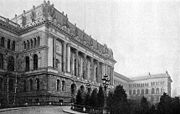 The institution was unified in 1879 under the name Royal Technical College of Charlottenburg (later Berlin) by merging the Building Academy (Bauakademie
The institution was unified in 1879 under the name Royal Technical College of Charlottenburg (later Berlin) by merging the Building Academy (Bauakademie
), established in 1799, and the Vocational Academy, established in 1829.
Since 1916 it has been integrated with the former Mining Academy, which was the oldest institution, founded in 1770.
The college was closed after World War II on 20 April 1945 and the university re-opened on 9 April 1946 under its current name.
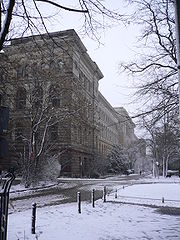
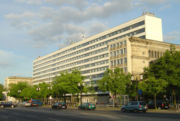
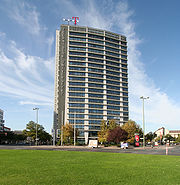
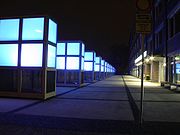 The TU Berlin covers ca. 600,000 m², distributed over various locations in Berlin.
The TU Berlin covers ca. 600,000 m², distributed over various locations in Berlin.
The main campus is located in the borough of Charlottenburg
. The seven schools of the university have some 28,200 students enrolled in more than 50 subjects (January, 2009).
International student mobility is applicable through ERASMUS programme
or through Top Industrial Managers for Europe
(TIME) network.
and is named officially "University Library of the TU Berlin and UdK (in the Volkswagen building)". Confusingly, the letters above the main entrance only state "Volkswagen Library
" – without any mentioning of the universities. All former 17 libraries of the Technical University of Berlin and of the nearby University of the Arts were merged into the new library, but several departments still retain libraries of their own. In particular, the school of 'Economics and Management' maintains a library with 340,000 volumes in the university's main building (Wirtschaftswissentschaftliche Dokumentation – WiWiDok).
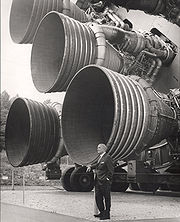
.jpg)
 (Including those of the Academies mentioned under History)
(Including those of the Academies mentioned under History)
.
The TU Berlin was founded in 1879 and, with nearly 30,000 students, is one of the largest technical universities in Germany. It also has the highest proportion of foreign students out of universities in Germany, with 20.9% in the summer semester of 2007, roughly 5,598 students. The university alumni and professor list include National Academies
United States National Academies
The United States National Academies comprises four organizations:* National Academy of Sciences * National Academy of Engineering * Institute of Medicine * National Research Council...
elections, 2 National Medal of Science
National Medal of Science
The National Medal of Science is an honor bestowed by the President of the United States to individuals in science and engineering who have made important contributions to the advancement of knowledge in the fields of behavioral and social sciences, biology, chemistry, engineering, mathematics and...
laureates and ten Nobel Prize
Nobel Prize
The Nobel Prizes are annual international awards bestowed by Scandinavian committees in recognition of cultural and scientific advances. The will of the Swedish chemist Alfred Nobel, the inventor of dynamite, established the prizes in 1895...
winners.
The TU Berlin is a member of the Top Industrial Managers for Europe
Top Industrial Managers for Europe
Top Industrial Managers for Europe is a network of more than fifty engineering schools and faculties and technical universities....
network, which allows for student exchanges between leading European engineering schools. It also belongs to the Conference of European Schools for Advanced Engineering Education and Research (CESAER
CESAER Association
The Conference of European Schools for Advanced Engineering Education and Research is a non-profit association of leading engineering universities in Europe. CESAER was set up on May 10, 1990, with headquarters in Leuven, Belgium...
). As of 2011, TU Berlin is ranked 46th (2010: 48th) in the world in the field of Engineering & Technology according to QS World University Rankings
QS World University Rankings
The QS World University Rankings is a ranking of the world’s top 500 universities by Quacquarelli Symonds using a method that has published annually since 2004....
.
History

Bauakademie
The Bauakademie in Berlin, Germany, built between 1832 and 1836, is considered one of the forerunners of modern architecture due to its theretofore uncommon use of red brick and the relatively streamlined facade of the building.Designed by Karl Friedrich Schinkel, the Bauakademie was built near...
), established in 1799, and the Vocational Academy, established in 1829.
Since 1916 it has been integrated with the former Mining Academy, which was the oldest institution, founded in 1770.
The college was closed after World War II on 20 April 1945 and the university re-opened on 9 April 1946 under its current name.
Campus




The main campus is located in the borough of Charlottenburg
Charlottenburg
Charlottenburg is a locality of Berlin within the borough of Charlottenburg-Wilmersdorf, named after Queen consort Sophia Charlotte...
. The seven schools of the university have some 28,200 students enrolled in more than 50 subjects (January, 2009).
Organization
Since 4 April 2005, the TU Berlin has consisted of the following schools:- HumanitiesHumanitiesThe humanities are academic disciplines that study the human condition, using methods that are primarily analytical, critical, or speculative, as distinguished from the mainly empirical approaches of the natural sciences....
- MathematicsMathematicsMathematics is the study of quantity, space, structure, and change. Mathematicians seek out patterns and formulate new conjectures. Mathematicians resolve the truth or falsity of conjectures by mathematical proofs, which are arguments sufficient to convince other mathematicians of their validity...
and Natural SciencesNatural scienceThe natural sciences are branches of science that seek to elucidate the rules that govern the natural world by using empirical and scientific methods... - Process Sciences and Engineering
- Electrical EngineeringElectrical engineeringElectrical engineering is a field of engineering that generally deals with the study and application of electricity, electronics and electromagnetism. The field first became an identifiable occupation in the late nineteenth century after commercialization of the electric telegraph and electrical...
and Computer ScienceComputer scienceComputer science or computing science is the study of the theoretical foundations of information and computation and of practical techniques for their implementation and application in computer systems... - Mechanical EngineeringMechanical engineeringMechanical engineering is a discipline of engineering that applies the principles of physics and materials science for analysis, design, manufacturing, and maintenance of mechanical systems. It is the branch of engineering that involves the production and usage of heat and mechanical power for the...
and Transport Systems (including Aerospace engineeringAerospace engineeringAerospace engineering is the primary branch of engineering concerned with the design, construction and science of aircraft and spacecraft. It is divided into two major and overlapping branches: aeronautical engineering and astronautical engineering...
, Automotive engineeringAutomotive engineeringModern automotive engineering, along with aerospace engineering and marine engineering, is a branch of vehicle engineering, incorporating elements of mechanical, electrical, electronic, software and safety engineering as applied to the design, manufacture and operation of motorcycles, automobiles,...
, naval and ocean engineering, and the planning and operation of transport systems) - Planning – Building – Environment (merge of former schools of "Civil EngineeringCivil engineeringCivil engineering is a professional engineering discipline that deals with the design, construction, and maintenance of the physical and naturally built environment, including works like roads, bridges, canals, dams, and buildings...
and Applied Geosciences" and "Architecture – EnvironmentNatural environmentThe natural environment encompasses all living and non-living things occurring naturally on Earth or some region thereof. It is an environment that encompasses the interaction of all living species....
– Society") - Economics and Management
Faculty and staff
7,601 people work at the university: 323 professors, 2,246 postgraduate researchers, and 2,078 personnel work in administration, the workshops, the library and the central facilities. In addition there are 2,301 student assistants and 142 trainees (March 2010).International student mobility is applicable through ERASMUS programme
Erasmus programme
The Erasmus Programme , a.k.a. Erasmus Project is a European Union student exchange programme established in 1987...
or through Top Industrial Managers for Europe
Top Industrial Managers for Europe
Top Industrial Managers for Europe is a network of more than fifty engineering schools and faculties and technical universities....
(TIME) network.
Library
The new common main library of the Technical University of Berlin and of the Berlin University of the Arts was opened in 2004 and holds about 2.9 million volumes (2007). The library building was sponsored partially (estimated 10% of the building costs) by VolkswagenVolkswagen
Volkswagen is a German automobile manufacturer and is the original and biggest-selling marque of the Volkswagen Group, which now also owns the Audi, Bentley, Bugatti, Lamborghini, SEAT, and Škoda marques and the truck manufacturer Scania.Volkswagen means "people's car" in German, where it is...
and is named officially "University Library of the TU Berlin and UdK (in the Volkswagen building)". Confusingly, the letters above the main entrance only state "Volkswagen Library
Volkswagen Library
The University Library of the TU Berlin and UdK is the central library of the Berlin Institute of Technology and the Berlin University of the Arts . It is located in the Fasanenstraße, Berlin...
" – without any mentioning of the universities. All former 17 libraries of the Technical University of Berlin and of the nearby University of the Arts were merged into the new library, but several departments still retain libraries of their own. In particular, the school of 'Economics and Management' maintains a library with 340,000 volumes in the university's main building (Wirtschaftswissentschaftliche Dokumentation – WiWiDok).
Notable alumni and professors

.jpg)

- August BorsigAugust BorsigJohann Friedrich August Borsig was a German businessman who founded the Borsig-Werke factory.Borsig was born in Breslau , the son of cuirassier and carpenter foreman Johann George Borsig...
(1804–1854), businessman - Carl BoschCarl BoschCarl Bosch was a German chemist and engineer and Nobel laureate in chemistry. He was a pioneer in the field of high-pressure industrial chemistry and founder of IG Farben, at one point the world's largest chemical company....
(1874–1940), chemist, Nobel prizeNobel PrizeThe Nobel Prizes are annual international awards bestowed by Scandinavian committees in recognition of cultural and scientific advances. The will of the Swedish chemist Alfred Nobel, the inventor of dynamite, established the prizes in 1895...
winner 1931 - Wernher von BraunWernher von BraunWernher Magnus Maximilian, Freiherr von Braun was a German rocket scientist, aerospace engineer, space architect, and one of the leading figures in the development of rocket technology in Nazi Germany during World War II and in the United States after that.A former member of the Nazi party,...
(1912–1976), head of Nazi Germany's V-2 rocketV-2 rocketThe V-2 rocket , technical name Aggregat-4 , was a ballistic missile that was developed at the beginning of the Second World War in Germany, specifically targeted at London and later Antwerp. The liquid-propellant rocket was the world's first long-range combat-ballistic missile and first known...
program, saved from prosecution at the Nuremberg TrialsNuremberg TrialsThe Nuremberg Trials were a series of military tribunals, held by the victorious Allied forces of World War II, most notable for the prosecution of prominent members of the political, military, and economic leadership of the defeated Nazi Germany....
by Operation PaperclipOperation PaperclipOperation Paperclip was the Office of Strategic Services program used to recruit the scientists of Nazi Germany for employment by the United States in the aftermath of World War II...
, first director of the United States National Aeronautics and Space Administration's (NASANASAThe National Aeronautics and Space Administration is the agency of the United States government that is responsible for the nation's civilian space program and for aeronautics and aerospace research...
) Marshall Space Flight CenterMarshall Space Flight CenterThe George C. Marshall Space Flight Center is the U.S. government's civilian rocketry and spacecraft propulsion research center. The largest center of NASA, MSFC's first mission was developing the Saturn launch vehicles for the Apollo moon program...
, called the father of the U.S. space program - Henri Marie Coandă (1886–1972), aircraft designer; discovered the Coandă EffectCoanda effectThe Coandă effect is the tendency of a fluid jet to be attracted to a nearby surface. The principle was named after Romanian aerodynamics pioneer Henri Coandă, who was the first to recognize the practical application of the phenomenon in aircraft development....
. - Krafft Arnold EhrickeKrafft Arnold Ehricke-External links:* * *...
(1917–1984), rocketRocketA rocket is a missile, spacecraft, aircraft or other vehicle which obtains thrust from a rocket engine. In all rockets, the exhaust is formed entirely from propellants carried within the rocket before use. Rocket engines work by action and reaction...
-propulsion engineer, worked for the NASANASAThe National Aeronautics and Space Administration is the agency of the United States government that is responsible for the nation's civilian space program and for aeronautics and aerospace research...
, chief designer of the D-1 CentaurCentaur (rocket stage)Centaur is a rocket stage designed for use as the upper stage of space launch vehicles. Centaur boosts its satellite payload to geosynchronous orbit or, in the case of an interplanetary space probe, to or near to escape velocity...
, the world's first upper-stage-booster that used liquid hydrogen and oxygen. - Gerhard ErtlGerhard ErtlGerhard Ertl is a German physicist and a Professor emeritus at the Department of Physical Chemistry, Fritz-Haber-Institut der Max-Planck-Gesellschaft in Berlin, Germany...
(* 10. Oktober 1936 in Stuttgart) Physicist and Surface Chemist, Hon. Prof. and Nobel prizeNobel PrizeThe Nobel Prizes are annual international awards bestowed by Scandinavian committees in recognition of cultural and scientific advances. The will of the Swedish chemist Alfred Nobel, the inventor of dynamite, established the prizes in 1895...
winner 2007 - Ernst StuhlingerErnst StuhlingerErnst Stuhlinger was a German-born American atomic, electrical and rocket scientist. After being brought to the United States as part of Operation Paperclip, he developed guidance systems with Wernher von Braun's team at the US Army, and later, NASA...
(1913–2008), member of the Army Ballistic Missile AgencyArmy Ballistic Missile AgencyThe Army Ballistic Missile Agency was the agency formed to develop the US Army's first intermediate range ballistic missile. It was established at Redstone Arsenal on February 1, 1956 and commanded by Major General John B...
, director of the space science lab at NASANASAThe National Aeronautics and Space Administration is the agency of the United States government that is responsible for the nation's civilian space program and for aeronautics and aerospace research...
's Marshall Space Flight CenterMarshall Space Flight CenterThe George C. Marshall Space Flight Center is the U.S. government's civilian rocketry and spacecraft propulsion research center. The largest center of NASA, MSFC's first mission was developing the Saturn launch vehicles for the Apollo moon program...
. - Heinz-Hermann KoelleHeinz-Hermann KoelleHeinz-Hermann Koelle was an aeronautical engineer who made the preliminary designs on the rocket that would emerge as the Saturn I...
(*1925) former director of the Army Ballistic Missile AgencyArmy Ballistic Missile AgencyThe Army Ballistic Missile Agency was the agency formed to develop the US Army's first intermediate range ballistic missile. It was established at Redstone Arsenal on February 1, 1956 and commanded by Major General John B...
, member of the launch crew on Explorer IExplorer IExplorer 1 was the first Earth satellite of the United States, launched as part of its participation in the International Geophysical Year...
and later directed the NASANASAThe National Aeronautics and Space Administration is the agency of the United States government that is responsible for the nation's civilian space program and for aeronautics and aerospace research...
's Marshall Space Flight CenterMarshall Space Flight CenterThe George C. Marshall Space Flight Center is the U.S. government's civilian rocketry and spacecraft propulsion research center. The largest center of NASA, MSFC's first mission was developing the Saturn launch vehicles for the Apollo moon program...
's involvement in Project ApolloProject ApolloThe Apollo program was the spaceflight effort carried out by the United States' National Aeronautics and Space Administration , that landed the first humans on Earth's Moon. Conceived during the Presidency of Dwight D. Eisenhower, Apollo began in earnest after President John F...
. - Klaus RiedelKlaus RiedelKlaus Riedel was a German rocket pioneer. He was involved in many early liquid-fuelled rocket experiments, and eventually worked on the V-2 missile programme at Peenemünde....
(1907–1944), German rocketRocketA rocket is a missile, spacecraft, aircraft or other vehicle which obtains thrust from a rocket engine. In all rockets, the exhaust is formed entirely from propellants carried within the rocket before use. Rocket engines work by action and reaction...
pioneer, worked on the V-2 missileV-2 rocketThe V-2 rocket , technical name Aggregat-4 , was a ballistic missile that was developed at the beginning of the Second World War in Germany, specifically targeted at London and later Antwerp. The liquid-propellant rocket was the world's first long-range combat-ballistic missile and first known...
programme at PeenemündePeenemündeThe Peenemünde Army Research Center was founded in 1937 as one of five military proving grounds under the Army Weapons Office ....
. - Arthur RudolphArthur RudolphArthur Louis Hugo Rudolph was a German rocket engineer and member of the Nazi party who played a key role in the development of the V-2 rocket. After World War II he was brought to the United States, subsequently becoming a pioneer of the United States space program. He worked for the U.S...
(1906–1996) worked for the U.S. Army and NASANASAThe National Aeronautics and Space Administration is the agency of the United States government that is responsible for the nation's civilian space program and for aeronautics and aerospace research...
, developer of Pershing missilePershing missilePershing was a family of solid-fueled two-stage medium-range ballistic missiles designed and built by Martin Marietta to replace the PGM-11 Redstone missile as the United States Army's primary nuclear-capable theater-level weapon. The Pershing systems lasted over 30 years from the first test...
and the Saturn VSaturn VThe Saturn V was an American human-rated expendable rocket used by NASA's Apollo and Skylab programs from 1967 until 1973. A multistage liquid-fueled launch vehicle, NASA launched 13 Saturn Vs from the Kennedy Space Center, Florida with no loss of crew or payload...
MoonMoonThe Moon is Earth's only known natural satellite,There are a number of near-Earth asteroids including 3753 Cruithne that are co-orbital with Earth: their orbits bring them close to Earth for periods of time but then alter in the long term . These are quasi-satellites and not true moons. For more...
rocket. - Walter DornbergerWalter DornbergerMajor-General Dr Walter Robert Dornberger was a German Army artillery officer whose career spanned World Wars I and II. He was a leader of Germany's V-2 rocket program and other projects at the Peenemünde Army Research Center....
(1895–1980), developer of the Air Force-NASANASAThe National Aeronautics and Space Administration is the agency of the United States government that is responsible for the nation's civilian space program and for aeronautics and aerospace research...
X-20 Dyna-Soar project. - Ottmar EdenhoferOttmar EdenhoferOttmar Georg Edenhofer is a German economist who deals with climate change policy and environmental and energy policy and energy economics...
(born 1961), economist - Wigbert FehseWigbert FehseWigbert Fehse is a German engineer and researcher in the area of automatic space navigation, guidance, control and docking/berthing.- Biography :...
(born 1937) German engineer and researcher in the area of automatic space navigation, guidance, control and docking/berthing. - Fritz GosslauFritz GosslauFritz Gosslau was a German engineer, known for his work on the V-1 flying bomb.-Study:...
(1898–1965), German engineer, known for his work at the V-1 flying bombV-1 flying bombThe V-1 flying bomb, also known as the Buzz Bomb or Doodlebug, was an early pulse-jet-powered predecessor of the cruise missile....
. - Fritz HoutermansFritz HoutermansFriedrich Georg "Fritz" Houtermans was a Dutch-Austrian-German atomic and nuclear physicist born in Zoppot near Danzig, West Prussia...
(1903–1966) atomic and nuclear physicist - Hugo JunkersHugo JunkersHugo Junkers was an innovative German engineer, as his many patents in varied areas show...
(1859–1935), former of JunkersJunkersJunkers Flugzeug- und Motorenwerke AG , more commonly Junkers, was a major German aircraft manufacturer. It produced some of the world's most innovative and best-known airplanes over the course of its fifty-plus year history in Dessau, Germany. It was founded there in 1895 by Hugo Junkers,...
& Co, a major German aircraft manufacturer. - Walter KaufmannWalter KaufmannWalter Arnold Kaufmann was a German-American philosopher, translator, and poet. A prolific author, he wrote extensively on a broad range of subjects, such as authenticity and death, moral philosophy and existentialism, theism and atheism, Christianity and Judaism, as well as philosophy and...
(1871–1947), physicist, well-known for his first experimental proof of the velocity dependence of mass. - Philipp MißfelderPhilipp MißfelderPhilipp Mißfelder is a German politician. He is chairman of the Junge Union, the youth organization of the CDU, and a member of the Bundestag, where he acts as Foreign Policy Spokesman for the Fraction of the Christian Democrats...
(*1979), German politician - Ida NoddackIda NoddackIda Noddack , née Ida Tacke, was a German chemist and physicist. She was the first to mention the idea of nuclear fission in 1934. With her husband Walter Noddack she discovered element 75 rhenium...
(1896–1978), nominated three times for Nobel Prize in ChemistryNobel Prize in ChemistryThe Nobel Prize in Chemistry is awarded annually by the Royal Swedish Academy of Sciences to scientists in the various fields of chemistry. It is one of the five Nobel Prizes established by the will of Alfred Nobel in 1895, awarded for outstanding contributions in chemistry, physics, literature,...
. - Georg Hans MadelungGeorg Hans MadelungGeorg Hans Madelung was a German academic and aeronautical engineer.Madelung studied at a several German Technical Universities before his service as a pilot in the First World War. After the war he lectured and worked in Germany and the United States, working on a number of significant...
(1889–1972), a GermanGermansThe Germans are a Germanic ethnic group native to Central Europe. The English term Germans has referred to the German-speaking population of the Holy Roman Empire since the Late Middle Ages....
academic and aeronautical engineer. - Franz BreisigFranz BreisigFranz Breisig was a German mathematician, chiefly known for his work on quadripoles , later to be known as two-port networks.-Publications:*Breisig, Dr F, Theoretische Telegraphie, Braunschweig, F...
(1868–1934), mathematician, inventor of the calibration wire and father of the term quadripole network in electrical engineeringElectrical engineeringElectrical engineering is a field of engineering that generally deals with the study and application of electricity, electronics and electromagnetism. The field first became an identifiable occupation in the late nineteenth century after commercialization of the electric telegraph and electrical... - Wilhelm CauerWilhelm CauerWilhelm Cauer was a German mathematician and scientist. He is most noted for his work on the analysis and synthesis of electrical filters and his work marked the beginning of the field of network synthesis...
(1900–1945), mathematician, essential contributions to the designFilter designFilter design is the process of designing a filter , often a linear shift-invariant filter, that satisfies a set of requirements, some of which are contradictory...
of filterFilter (signal processing)In signal processing, a filter is a device or process that removes from a signal some unwanted component or feature. Filtering is a class of signal processing, the defining feature of filters being the complete or partial suppression of some aspect of the signal...
s - Carl DahlhausCarl DahlhausCarl Dahlhaus , a musicologist from Berlin, was one of the major contributors to the development of musicology as a scholarly discipline during the post-war era....
(1928–1989), musicologist - Dennis GaborDennis GaborDennis Gabor CBE, FRS was a Hungarian-British electrical engineer and inventor, most notable for inventing holography, for which he later received the 1971 Nobel Prize in Physics....
(1900–1971), physicist (holographyHolographyHolography is a technique that allows the light scattered from an object to be recorded and later reconstructed so that when an imaging system is placed in the reconstructed beam, an image of the object will be seen even when the object is no longer present...
), Nobel prize winner 1971 - Fritz HaberFritz HaberFritz Haber was a German chemist, who received the Nobel Prize in Chemistry in 1918 for his development for synthesizing ammonia, important for fertilizers and explosives. Haber, along with Max Born, proposed the Born–Haber cycle as a method for evaluating the lattice energy of an ionic solid...
(1868–1934), chemist, Nobel prizeNobel PrizeThe Nobel Prizes are annual international awards bestowed by Scandinavian committees in recognition of cultural and scientific advances. The will of the Swedish chemist Alfred Nobel, the inventor of dynamite, established the prizes in 1895...
winner 1918 - Sabine HarkSabine HarkSabine Hark is a German feminist and sociologist.She studied sociology and political science at Mainz and Frankfurt am Main. She received her doctorate from the Free University of Berlin in 1995. From 1997 until 2005 she has taught sociology of gender at the University of Potsdam...
(born 7 August 1962), sociologist and professor of gender studiesGender studiesGender studies is a field of interdisciplinary study which analyses race, ethnicity, sexuality and location.Gender study has many different forms. One view exposed by the philosopher Simone de Beauvoir said: "One is not born a woman, one becomes one"... - Gustav Ludwig HertzGustav Ludwig HertzGustav Ludwig Hertz was a German experimental physicist and Nobel Prize winner, and a nephew of Heinrich Rudolf Hertz.-Biography:...
(1887–1975), physicist, Nobel prize winner 1925 - George de HevesyGeorge de HevesyGeorge Charles de Hevesy, Georg Karl von Hevesy, was a Hungarian radiochemist and Nobel laureate, recognized in 1943 for his key role in the development of radioactive tracers to study chemical processes such as in the metabolism of animals.- Early years :Hevesy György was born in Budapest,...
(1885–1966), chemist, Nobel prize winner 1943 - Karl KüpfmüllerKarl KüpfmüllerKarl Küpfmüller was a German electrical engineer, who was prolific in the areas of communications technology, measurement and control engineering, acoustics, communication theory and theoretical electro-technology....
(1897–1977), electrical engineerElectrical engineeringElectrical engineering is a field of engineering that generally deals with the study and application of electricity, electronics and electromagnetism. The field first became an identifiable occupation in the late nineteenth century after commercialization of the electric telegraph and electrical...
, essential contributions to system theory - Wassili LuckhardtWassili LuckhardtWassili Luckhardt was a German architect. He studied at the Technical University of Berlin and Dresden. Luckhardt and his brother Hans worked closely together for most of their lives...
(1889–1972), architect - Alexander MeissnerAlexander MeissnerAlexander Meissner was Austrian engineer and physicist. He was born in Vienna and died in Berlin....
(1883–1958), electrical engineerElectrical engineeringElectrical engineering is a field of engineering that generally deals with the study and application of electricity, electronics and electromagnetism. The field first became an identifiable occupation in the late nineteenth century after commercialization of the electric telegraph and electrical... - Ivan StranskiIvan StranskiIvan Nikolov Stranski was a Bulgarian physical chemist. The founder of the Bulgarian school of physical chemistry, Stranski is considered the father of crystal growth research. Stranski headed the departments of physical chemistry at Sofia University and the Technical University of Berlin, of...
(1897–1979), chemist, considered the father of crystal growthCrystal growthA crystal is a solid material whose constituent atoms, molecules, or ions are arranged in an orderly repeating pattern extending in all three spatial dimensions. Crystal growth is a major stage of a crystallization process, and consists in the addition of new atoms, ions, or polymer strings into...
research - Adolf SlabyAdolf SlabyAdolf Karl Heinrich Slaby was a German wireless pioneer and the first Professor of electro-technology at the Technical University of Berlin .-Education:Slaby was born in Berlin, the son of a bookbinder...
(1849–1913), German wirelessWirelessWireless telecommunications is the transfer of information between two or more points that are not physically connected. Distances can be short, such as a few meters for television remote control, or as far as thousands or even millions of kilometers for deep-space radio communications...
pioneer - Alois RiedlerAlois RiedlerAlois Riedler was a noted Austrian mechanical engineer, and, as professor in Germany, a vigorous proponent of practically-oriented engineering education....
(1850–1936), vigorous proponent of practically-oriented engineering education - Erwin Wilhelm MüllerErwin Wilhelm MüllerErwin Wilhelm Müller was a German physicist who invented the Field Emission Electron Microscope , the Field Ion Microscope , and the Atom-Probe Field Ion Microscope...
(1911–1977), physicist (field emission microscope, field ion microscopeField ion microscopeField ion microscopy is an analytical technique used in materials science. The field ion microscope is a type of microscope that can be used to image the arrangement of atoms at the surface of a sharp metal tip....
, atom probeAtom probeThe atom probe is a microscope used in material science that was invented in 1967 by Erwin Wilhelm Müller, J. A. Panitz, and S. Brooks McLane. The atom probe is closely related to the method of Field Ion Microscopy, which is the first microscopic method to achieve atomic resolution, occurring in...
) - Jakob Karol Parnas (1884–1949), biochemist, Embden-Meyerhof-ParnasGlycolysisGlycolysis is the metabolic pathway that converts glucose C6H12O6, into pyruvate, CH3COCOO− + H+...
pathway - Wolfgang PaulWolfgang PaulWolfgang Paul was a German physicist, who co-developed the non-magnetic quadrupole mass filter which laid the foundation for what we now call an ion trap...
(1913–1993), physicist, Nobel prize winner 1989 - Ernst RuskaErnst RuskaErnst August Friedrich Ruska was a German physicist who won the Nobel Prize in Physics in 1986 for his work in electron optics, including the design of the first electron microscope.Ruska was born in Heidelberg...
(1906–1988), physicist (electron microscopeElectron microscopeAn electron microscope is a type of microscope that uses a beam of electrons to illuminate the specimen and produce a magnified image. Electron microscopes have a greater resolving power than a light-powered optical microscope, because electrons have wavelengths about 100,000 times shorter than...
), Nobel prize winner 1986 - Karl Friedrich SchinkelKarl Friedrich SchinkelKarl Friedrich Schinkel was a Prussian architect, city planner, and painter who also designed furniture and stage sets. Schinkel was one of the most prominent architects of Germany and designed both neoclassical and neogothic buildings.-Biography:Schinkel was born in Neuruppin, Margraviate of...
(1781–1841), architect (at the predecessor Berlin Building Academy) - Georg Schlesinger (1874–1949)
- Franz ReuleauxFranz ReuleauxFranz Reuleaux , was a mechanical engineer and a lecturer of the Berlin Royal Technical Academy, later appointed as the President of the Academy. He was often called the father of kinematics...
(1829–1905), mechanical engineer, often called the father of kinematicsKinematicsKinematics is the branch of classical mechanics that describes the motion of bodies and systems without consideration of the forces that cause the motion.... - Albert SpeerAlbert SpeerAlbert Speer, born Berthold Konrad Hermann Albert Speer, was a German architect who was, for a part of World War II, Minister of Armaments and War Production for the Third Reich. Speer was Adolf Hitler's chief architect before assuming ministerial office...
(1905–1981), architect, politician, Minister for Armaments during the Third Reich, was sentenced to 20 years prison in the Nuremberg trialsNuremberg TrialsThe Nuremberg Trials were a series of military tribunals, held by the victorious Allied forces of World War II, most notable for the prosecution of prominent members of the political, military, and economic leadership of the defeated Nazi Germany.... - Kurt TankKurt TankKurt Waldemar Tank was a German aeronautical engineer and test pilot, heading the design department at Focke-Wulf from 1931-45. He designed several important aircraft of World War II, including the Focke-Wulf Fw 190 fighter aircraft.-Early life:Tank was born in Bromberg , Province of Posen...
(1893–1983), head of design department of Focke-WulfFocke-WulfFocke-Wulf Flugzeugbau AG was a German manufacturer of civil and military aircraft before and during World War II. Many of the company's successful fighter aircraft designs were slight modifications of the Focke-Wulf Fw 190.-History:...
, designed the FW-190 - Wilhelm Heinrich Westphal (1882–1978), physicist
- Günter M. ZieglerGünter M. ZieglerGünter M. Ziegler is a German mathematician. Ziegler is known for his research in discrete mathematics and geometry, and particularly on the combinatorics of polytopes.- Biography :...
(*1963), Gottfried Wilhelm Leibniz PrizeGottfried Wilhelm Leibniz PrizeThe Gottfried Wilhelm Leibniz Prize is a research prize awarded by the Deutsche Forschungsgemeinschaft every year since 1985 to scientists working in Germany. This highest German research prize consists of a research grant of 2.5 million euro, to be used within seven years...
(2001) - Hermann W. VogelHermann W. VogelHermann Wilhelm Vogel was a German photochemist and photographer who made a key discovery of great importance to photography.-Academic career:...
, (1834–1898) photo-chemist - Eugene Wigner (1902–1995), physicist, discovered the Wigner-Ville-distribution, Nobel prize winner 1963
- Konrad ZuseKonrad ZuseKonrad Zuse was a German civil engineer and computer pioneer. His greatest achievement was the world's first functional program-controlled Turing-complete computer, the Z3, which became operational in May 1941....
(1910–1995), computer pioneer - Abdul Qadeer KhanAbdul Qadeer KhanAbdul Qadeer Khan , also known in Pakistan as Mohsin-e-Pakistan , D.Eng, Sc.D, HI, NI , FPAS; more widely known as Dr. A. Q...
Pakistani nuclear scientist
See also
Other Universities of Berlin:- Berlin School of Economics and Law
- Freie Universität Berlin (Free University of Berlin)
- Hertie School of GovernanceHertie School of GovernanceThe Hertie School of Governance is a private university in Berlin, in the historic Quartier 110 of Friedrichstraße. The school is regarded as one of the leading policy institutes in Europe...
- Humboldt Universität zu Berlin (Humboldt University of Berlin)
- Universität der Künste (Berlin University of the Arts)
Rankings
As of 2011, TU Berlin is ranked 46th (2010: 48th) in the world in the field of Engineering & Technology according to QS World University RankingsQS World University Rankings
The QS World University Rankings is a ranking of the world’s top 500 universities by Quacquarelli Symonds using a method that has published annually since 2004....
.

